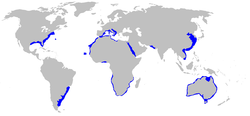Sand tiger shark
| Grey Nurse Shark (Sand Tiger Shark) | |
|---|---|

| |
| Scientific classification | |
| Kingdom: | |
| Phylum: | |
| Class: | |
| Subclass: | |
| Order: | |
| Family: | |
| Genus: | |
| Species: | C. taurus
|
| Binomial name | |
| Carcharias taurus Rafinesque, 1810
| |

| |
| Range of the grey nurse shark (in blue) | |
The grey nurse shark (Australia), spotted ragged-tooth shark (Africa) or sand tiger shark (US and UK), Carcharias taurus, is a large shark inhabiting coastal waters worldwide, with many different names in different countries in the world. Despite a fearsome appearance and strong swimming abilities, it is a relatively placid and slow moving animal. It is considered not aggressive unless provoked.[1] It is considered the most widely kept shark in public aquariums around the world, due to its fairly large size, its higher adaptability to captivity than other large shark and its crooked, fierce-looking teeth.[2][3]
Anatomy and appearance
The body is stout, with two large dorsal fins and the tail is elongated and has a long upper lobe. The shark has a precaudal pit but no caudal keels. It grows to a length of 3.5 m (about 11 ft). This shark weighs 90 to 160 kg (200 to 350 lb).[4] A maximum weight of 300 kg (660 lb) has been reported.[5]
The grey nurse shark usually has a grey back and white underside. In August 2007, an albino specimen was photographed off South West Rocks, Australia.[6]
Diet
The diet of Carcharias taurus consists of fish, young sharks and rays, squid, and crustaceans.[7]
Behaviour
The sharks typically congregate in coastal waters, at depths of between 60 and 190 m, although deeper depths have been recorded. Often they will shelter in caves or gutters during the day, and come out at night to feed. During the day they exhibit sluggish behavior, becoming more active during the night. The grey nurse shark is the only known shark to gulp and store air in its stomach in order to maintain neutral buoyancy while swimming.
While it is commonly reported that grey nurse sharks are harmless, data compiled by ISAF records 76 attacks on humans, of which 29 have been classified as unprovoked. Two of those unprovoked attacks have resulted in fatalities.[8]

Reproduction
The species practice adelphophagy, a form of viviparity where the embryos eat each other. Female sharks have two uteruses. Inside the uterus the young sharks develop and eat from the yolk sac and then on each other until there are only two young left, one in each of the uteri. To provide further nourishment for her young, the mother continues to produce eggs that are eaten by her two remaining young. After two years the young are around 1 m long, miniature replicas of their mother and fully able to fend for themselves and she gives birth to them in a lengthy labour.[9] There are reports of biologists probing the bellies of landed females and having their fingers nipped by the cannibalistic young with their fully developed teeth.
This fascinating reproductive strategy, also known as intrauterine cannibalism is making it harder for the shark population to rebound from near extinction. As a result, scientists plan to artificially inseminate and breed the sharks, in order to increase their population.[10] Another plan is to remove the shark embryos from the uterus before cannibalism can take place and then artificially gestate them.[11]
Conservation status
It is listed as vulnerable on the IUCN Red List, and as endangered under Queensland's Nature Conservation Act 1992. It is a U.S. National Marine Fisheries Service Species of Concern. Species of Concern are those species about which the U.S. Government’s National Oceanic and Atmospheric Administration, National Marine Fisheries Service (NMFS), has some concerns regarding status and threats, but for which insufficient information is available to indicate a need to list the species under the U.S. Endangered Species Act.
For further information on conservation status and measures, see grey nurse shark conservation.
See also
- Nurse shark, Ginglymostoma cirratum
Gallery
-
Grey nurse shark at the Minnesota Zoo
-
Grey nurse shark's jaw
-
Grey nurse shark's lower jaw
-
Detail of a grey nurse shark's lower jaw
Footnotes
- ^ Sandtiger Shark profile at the Florida Museum of National History.
- ^ http://www.ceoe.udel.edu/kiosk/sandtigershark.html
- ^ http://www.elasmo-research.org/education/shark_profiles/c_taurus.htm
- ^ <http://www.ife.org/index.cgi/639?highlight=extremes>
- ^ http://www.elasmo-research.org/education/shark_profiles/c_taurus.htm
- ^ Rare albino shark rules deep The Daily telegraph (Australia), August 8, 2007.
- ^ Recovery Plan for the Grey Nurse Shark in Australia
- ^ Florida Museum of Natural History Ichthyology Department: Sandtiger Shark
- ^ Piper, Ross (2007), Extraordinary Animals: An Encyclopedia of Curious and Unusual Animals, Greenwood Press.
- ^ Scientists to breed test-tube sharks, CNN.
- ^ Sibling sharks turn predator in the grey nursery, Sydney Morning Herald.
References
- Template:IUCN2006 Database entry includes justification for why this species is vulnerable
- Barry Bruce, John Stevens, Nick Otway: Site fidelity, residency times and activity space in grey nurse sharks in eastern Australia
- Froese, Rainer; Pauly, Daniel (eds.) (2005). "Carcharias taurus" in FishBase. 09 2005 version.
- "Carcharias taurus". Integrated Taxonomic Information System. Retrieved 23 January 2006.
- Grey Nurse Shark, Carcharias taurus at marinebio.org






